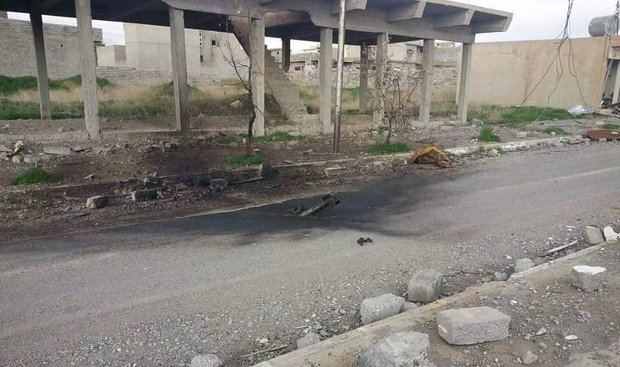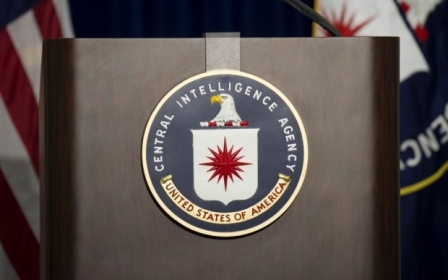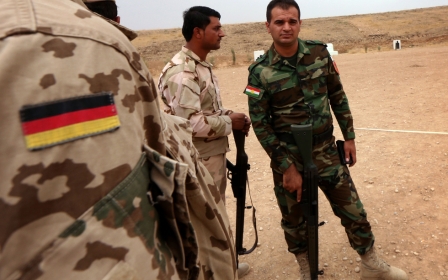Poisonous war: Low-tech chemical rockets become growing IS threat

ERBIL - The men stationed in the devastated town of Sinjar in northern Iraq had just finished lunch when they were startled by a swooshing sound from above.
Rockets began smashing into the road and tearing up the asphalt, their fins sticking out from the ground like oversized arrow fletchings.
But the rockets did not explode as normal, and there was little blast effect. Instead, a strong smell began to emerge from the scorched highway.
"At first, we felt nothing, we just noticed an unpleasant smell. But after a few hours we began to feel unwell and started to vomit," Ahmed Musa, an Iraqi policeman who watched as the rockets fell near his station on 25 February, told Middle East Eye.
These rockets were not designed to explode - but to poison those unlucky enough to be close to impact. Their content was chemical.
The Islamic State (IS) group had made use of chemical agents in Iraq before, firing gas-filled mortar bombs at Kurdish lines near Sinjar earlier in the month. But this time, the group extended its range with the use of homemade rockets, known in Iraq as Katyushas in reference to a Russian missile system.
"We think that they are locally produced. It's quite obvious, they are just made with normal pipes," Mohammed Ilias, a major with the Kurdish internal security agency, the Asayish, who was sickened by the attack, told MEE.
In all, 19 Katyushas rained down, according to Dave Eubanks of the aid organisation Free Burmese Rangers, who saw the attack. This number was corroborated by Ilias, who was one of 27 members of his unit who needed treatment.
As the gas spread through the air, it was inhaled by more than one hundred Kurdish and Iraqi security personnel, and Sinjar hospital was soon overwhelmed by patients suffering from severe headaches, nausea and vomiting.
About 170 victims of the gas were treated on Thursday and Friday, according to hospital staff, who injected hydrocortisone and provided oxygen masks.
Isolated and vulnerable
Situated in a remote corner of northern Iraq, Sinjar is one of the most isolated sections of the Kurdish frontline that stretches over 1,000km from east to west. The town remains largely abandoned after it was liberated from IS in November, but their fighters are still close enough to launch attacks.
With depleted stocks following the gas attack, medical staff are worried about follow-up assaults.
"We don't have many things at the hospital. Maybe ISIS [IS] will attack tonight or tomorrow, then we have a problem," said Kalesh Edo, a nurse at the hospital.
Kurdish fighters and the Iraqi police units in Sinjar are ill-prepared to deal with poison gas. They have no gas masks, or clothing treated to withstand its effects.
"We don't have any protection," said Dilshad Anjo, a member of the Asayish, who spent four hours in the hospital receiving treatment. "I think it will happen again, and I am worried."
Anjo has good reason to be concerned. The Katyusha attack was preceded by a gas attack on 11 February that saw an estimated 30 mortar rounds hit Kurdish Peshmerga fighters holding the frontline on the outskirts of the town, said Eubanks.
Hundreds struck down
A total of 175 Peshmerga were sickened in the attack, according to Matthew Barber, who heads Yazda, an organisation supporting the Yazidi minority of Sinjar. Two days later, on 27 February, a few mortar rounds filled with gas hit Peshmerga positions in villages near the town.
Sinjar, which was recaptured by Kurdish forces last year, remains a major target for IS, even though it has now become a symbol of the group's declining military fortunes.
In August 2014, the group stormed into the plains surrounding the town, quickly taking the area after the Peshmerga retreated.
IS fighters caught up with the fleeing local Yazidi population, killing and enslaving thousands, and laid siege to Mount Sinjar, where the remaining residents put up a desperate defence. About 3,000 Yazidi women and children are still held by IS.
When the Kurds recaptured the town, they cut off a vital supply line between Mosul and Raqqa in Syria, the most important cities in IS's self-proclaimed caliphate.
Yet the town remains within striking distance of IS and its Katyushas, which keeps the local population, with the exception of a handful of Yazidi families, from returning.
"The IS threat remains conspicuous in the Yazidis' backyard and most feel hopeless about a return to normal life," said Barber.
Flying pipe-bombs
Edo, the nurse at the local hospital, said it was not clear at this stage if the rockets on 25 February had been filled with mustard gas or chlorine gas until samples had been analysed.
But fortunately for the Kurds, no one has died in the attacks as IS lacks the means to deliver the gas in a more sophisticated form.
"The method of delivery is so crude it tends to dissipate the chemicals before they can be focused into an area concentrated enough to kill people. They lack sufficient bursting technology to make their weapons more lethal," said Michael Stephens, a research fellow at the Royal United Services Institute (RUSI).
IS gas attacks are intended to throw enemy lines into disarray, but the use of gas is now also becoming a means to terrorise at a time when the group's military strength is waning.
The simplicity of the group's chemical weapons and delivery systems also makes it difficult for the coalition to prevent their manufacture. Chlorine and mustard agents can be produced from basic chemicals, while the Katyushas are little more than flying pipes.
The primitive weapons are hard to spot from the air, and can be hidden with relative ease before being put into use.
"It's extremely hard to prevent. This is a group that controls large swathes of territory," said Malik Ellahi, a spokesman for the Organisation for the Prohibition of Chemical Weapons (OPCW).
The coalition has been paying attention to IS's chemical weapons programme, and is looking to hit it wherever it can, top officials have said.
"I'm just telling you, it's something we watch very closely and it's something we take action against," US Defence Secretary Ashton Carter told PBS last month. Carter indicated that aircraft had already struck locations where the coalition suspected chemical weaponry.
But as long as the group holds large parts of Syria and Iraq, it will likely find ways to produce poison gas, and may even find ways to create lethal payloads.
Despite the coalition air campaign, IS has proven adept at maintaining a steady production of improvised explosive devices (IEDs), self-made mines and explosive charges that are responsible for the bulk of Kurdish casualties, and continues to develop more complex and deadly versions.
Chemical attacks are set to become an increasingly common feature in the group's arsenal, experts said.
"I expect [the attacks] to continue, and I expect them to escalate," Stephens said. "IS has shown that it is prepared to use chemical weapons in offensives if it possesses the means to do so.
"Particularly if their backs are against the wall I can imagine this will be a modus operandi."
New MEE newsletter: Jerusalem Dispatch
Sign up to get the latest insights and analysis on Israel-Palestine, alongside Turkey Unpacked and other MEE newsletters
Middle East Eye delivers independent and unrivalled coverage and analysis of the Middle East, North Africa and beyond. To learn more about republishing this content and the associated fees, please fill out this form. More about MEE can be found here.





